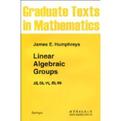线性代数群
出版时间:2009-4 出版社:世界图书出版公司 作者:汉弗莱斯 页数:253
Tag标签:无
内容概要
For this printing, I have corrected some errors and made numerous minor changes in the interest of clarity. The most significant corrections occur in Sections 4.2, 4.3, 5.5, 30.3, 32.1, and 32.3. I have also updated the biblio-graphy to some extent. Thanks are due to a number of readers who took the trouble to point out errors, or obscurities; especially helpful were the detailed comments of Jose Antonio Vargas.
书籍目录
I.AlgebraicGeometry0.SomeCommutativeAlgebra1.AffineandProjectiveVarieties1.1 IdealsandAflineVarieties1.2 ZariskiTopologyonAffineSpace1.3 IrreducibleComponents1.4 ProductsofAffineVarieties1.5 AffineAlgebrasandMorphisms1.6 ProjectiveVarieties1.7 ProductsofProjectiveVarieties1.8 FlagVarieties2.Varieties2.1 LocalRings2.2 Prevarieties2.3 Morphisms2.4 Products2.5 HausdorffAxiom3.Dimension3.1 DimensionofaVariety3.2 DimensionofaSubvariety3.3 DimensionTheorem3.4 Consequences4.Morphisms4.1 FibresofaMorphism4.2 FiniteMorphisms4.3 ImageofaMorphism4.4 ConstructibleSets4.5 OpenMorphisms4.6 BijectiveMorphisms4.7 BirationalMorphisms5.TangentSpaces5.1 ZariskiTangentSpace5.2 ExistenceofSimplePoints5.3 LocalRingofaSimplePoint5.4 DifferentialofaMorphism5.5 DifferentialCriterionforSeparability6.CompleteVarieties6.1 BasicProperties6.2 CompletenessofProjectiveVarieties6.3 VarietiesIsomorphictoP6.4 AutomorphismsofPII.AflineAlgebraicGroups7.BasicConceptsandExamples7.1 TheNotionofAlgebraicGroup7.2 SomeClassicalGroups7.3 IdentityComponent7.4 SubgroupsandHomomorphisms7.5 GenerationbyIrreducibleSubsets7.6 HopfAIgebras8.ActionsofAlgebraicGroupsonVarieties8.1 GroupActions8.2 ActionsofAlgebraicGroups8.3 ClosedOrbits8.4 SemidirectProducts8.5 TranslationofFunctions8.6 LinearizationofAffineGroupsIII.LieAlgebras9.LieAlgebraofanAlgebraicGroup9.1 LieAlgebrasandTangentSpaces9.2 Convolution9.3 Examples9.4 SubgroupsandLieSubalgebras9.5 DualNumbers10.Differentiation10.1 SomeElementaryFormulas10.2 DifferentialofRightTranslation10.3 TheAdjointRepresentation10.4 DifferentialofAd10.5 Commutators10.6 Centralizers10.7 AutomorphismsandDerivationsIV.HomogeneousSpaces11.ConstructionofCertainRepresentations11.1 ActiononExteriorPowers11.2 ATheoremofChevalley11.3 PassagetoProjectiveSpace11.4 CharactersandSemi-lnvariants11.5 NormalSubgroups12.Quotients12.1 UniversalMappingProperty12.2 TopologyofY12.3 FunctionsonY12.4 Complements12.5 Characteristic0V.Characteristic0Theory13.CorrespondenceBetweenGroupsandLieAlgebras13.1 TheLatticeCorrespondence13.2 InvariantsandInvariantSubspaces13.3 NormalSubgroupsandIdeals13.4 CentersandCentralizers13.5 SemisimpleGroupsandLieAlgebras14.SemisimpleGroups14.1 TheAdjointRepresentation14.2 SubgroupsoraSemisimpleGroup14.3 CompleteReducibilityofRepresentationsVI.SemisimpleandUnipotentElements15.Jordan-ChevalleyDecomposition15.1 DecompositionofaSingleEndomorphism15.2 GL(n,K)andgl(n,K)15.3 JordanDecompositioninAlgebraicGroups15.4 CommutingSetsofEndomorphisms15.5 StructureofCommutativeAlgebraicGroups16.DiagonalizableGroups16.1 Charactersandd-Groups16.2 Tori16.3 RigidityofDiagonalizableGroups16.4 WeightsandRootsVII.SolvableGroups17.NilpotentandSolvableGroups17.1 AGroup-TheoreticLemma17.2 CommutatorGroups17.3 SolvableGroups17.4 NilpotentGroups17.5 UnipotentGroups17.6 Lie-KolchinTheorem18.SemisimpleElements18.1 GlobalandInfinitesimalCentralizers18.2 ClosedConjugacyClasses18.3 ActionofaSemisimpleElementonaUnipotentGroup18.4 ActionofaDiagonalizableGroup19.ConnectedSolvableGroups19.1 AnExactSequence19.2 TheNilpotentCase19.3 TheGeneralCase19.4 NormalizerandCentralizer19.5 SolvableandUnipotentRadicals20.OneDimensionalGroups20.1 CommutativityofG20.2 VectorGroupsande-Groups20.3 Propertiesofp-Polynomials20.4 AutomorphismsofVectorGroups20.5 TheMainTheoremVIII.BorelSubgroups21.FixedPointandConjugacyTheorems21.1 ReviewofCompleteVarieties21.2 FixedPointTheorem21.3 ConjugacyofBorelSubgroupsandMaximalTori21.4 FurtherConsequences22.DensityandConnectednessTheorems22.1 TheMainLemma22.2 DensityTheorem22.3 ConnectednessTheorem22.4 BorelSubgroupsofCG(S)22.5 CartanSubgroups:Summary23.NormalizerTheorem23.1 StatementoftheTheorem23.2 ProofoftheTheorem23.3 TheVarietyG/B23.4 SummaryIX.CentralizersofTori24.RegularandSingularTori24.1 WeylGroups24.2 RegularTori24.3 SingularToriandRoots24.4 Regular1-ParameterSubgroups25.ActionofaMaximalTorusonG/B25.1 Actionofa1-ParameterSubgroup25.2 ExistenceofEnoughFixedPoints25.3 GroupsofSemisimpleRank125.4 WeylChambers26.TheUnipotentRadical26.1 CharacterizationofRu(G)26.2 SomeConsequences26.3 TheGroupsUaX.StructureofReductiveGroups27.TheRootSystem27.1 AbstractRootSystems27.2 TheIntegralityAxiom27.3 SimpleRoots27.4 TheAutomorphismGroupofaSemisimpleGroup27.5 SimpleComponents28.BruhatDecomposition28.1 T-StableSubgroupsofBu28.2 GroupsofSemisimpleRank128.3 TheBruhatDecomposition28.4 NormalForminG28.5 Complements29.TitsSystems29.1 Axioms29.2 BruhatDecomposition29.3 ParabolicSubgroups29.4 GeneratorsandRelationsforW29.5 NormalSubgroupsofG30.ParabolicSubgroups30.1 StandardParabolicSubgroups30.2 LeviDecompositions30.3 ParabolicSubgroupsAssociatedtoCertainUnipotentGroups30.4 MaximalSubgroupsandMaximalUnipotentSubgroupsXI.RepresentationsandClassificationofSemisimpleGroups31.Representations31.1 Weights31.2 MaximalVectors31.3 IrreducibleRepresentations31.4 ConstructionofIrreducibleRepresentations31.5 MultiplicitiesandMinimalHighestWeights31.6 ContragredientsandInvariantBilinearForms32.IsomorphismTheorem32.1 TheClassificationProblem32.2 ExtensionofψTtoN(T)32.3 ExtensionofψTtoZa32.4 ExtensionofψTtoTUa32.5 ExtensionofψTtoB32.6 Multiplicativityofψ33.RootSystemsofRank233.1 Reformulationof(A),(B),(C)33.2 SomePreliminaries33.3 TypeA233.4 TypeB233.5 TypeG233.6 TheExistenceProblemXII.SurveyofRationalityProperties34.FieldsofDefinition34.1 Foundations34.2 ReviewofEarlierChapters34.3 Tori34.4 SomeBasicTheorems34.5 Borei-TitsStructureTheory34.6 AnExample:OrthogonalGroups35.SpecialCases35.1 SplitandQuasisplitGroups35.2 FiniteFields35.3 TheRealField35.4 LocalFields35.5 ClassificationAppendix.RootSystemsBibliographyIndexofTerminologyIndexofSymbols
章节摘录
Over the last two decades the Borel-Chevalley theory of Iinear algebraic groups(as further developed by Borel,Steinberg,Tits,and others)has made possible significant progress In a aurabef of areas:scmisimple Lie groups and arithmetic subgroups,p-adic groups,classical linear groups,finite simple groups,invariant theory。etc.Unfortunately,the subject has not been as accessible as it ought to be.in part due to the fairly substantial background in algebraic geometry assumed by Chevalley ,Borei , Borel,Tits .The difliculty of the theory also stems in Dart from the fact that the main results culminate a Iong series of arguments which are hard to“see through”from beginning to end.In writing this introductory text. aimed at the second year graduate level.I have tried to take these factors into account. First.the requisite algebraic geometry has been treated in fullin Chapter I.modulo some more.or-less standard results from commutative algebra (quoted in§o),e.g.,the theorem that a regular local ring is an integrally closed domain.The treatment is intentionally somewhat crude and is not at all scheme-oriented.In fact.everything is done over an algebraically closed field K(of arbitrary characteristic).even though most of the eventual applications involve a feld of definition k.I believe this c.an be iustified as follows.In order to work over k from the outset,it would be necessary to spend a good deal of time perfecting the foundations.and then the only rationality statements proved along the way would be Of a minor sort rcf (34.2)).The deeper rationality properties can only be appreciated after the reader has reached Chapter X.(A survey of such results,without proofs, is given in Chapter XlI.) Second.a special effort has been made to render the exposition trans. parent.Except for a digression into characteristic 0 in Chapter V.the development from Chapter II to Chapter XI is fairly“linear”.covering the foundations,the structure of connected solvable groups,and then the structure,representations and classification of reductive groups.The Iecture notes of BoreI 41,which constitute an improvement of the methods in Chevalley,are the basic source for Chapters II-IV,Vl-X,while Chapter xI is a hybrid of Chevalley and SGAD.From27 on the basic facts about root systems arc used constantly:these are listed(with suitable ref- erences)in the Appendix.Apart from{io,the Appendix,and a reference to a theorem of Burnside in(1 7.5),the text iS self-contained.But the reader is asked to verifv some minor ooints as exercises. ……
图书封面
图书标签Tags
无
评论、评分、阅读与下载
用户评论 (总计0条)
相关图书
- 数论中的模函数和狄利克莱级数
- 中国福利会学前教育课程 生活领域
- 国际形势和中国外交蓝皮书
- 放眼看天下
- 人体解剖学
- 不怕被利用就怕你没用
- 财政信息化研究
- この胸に深々と突き刺さる矢を抜け〈上〉
- この胸に深々と突き刺さる矢を抜け〈下〉
- 經典私塾班:傅佩榮與青少年讀易經
- 如何开发孩子的8大潜能
- “三高”调养食谱
- 齐鲁书社30年图书要目
- 上海城乡经济社会发展一体化难题破解研究
- 今晚有事不回家 - - 都市主流人群婚外情感采访实录
- 2009在职攻读硕士学位全国联考英语考试词汇速记
- 献给陈楚生的120首情歌
- 修图魔法师
- Photoshop CS4数码照片处理从入门到精通
- Photoshop CS4从入门到精通
- 不思議飴玉 増量版
- まるで初めての恋みたいに
- TSUBASA翼(02)
- 战胜华尔街
- 百年留影--照片中的20世纪 上下册
